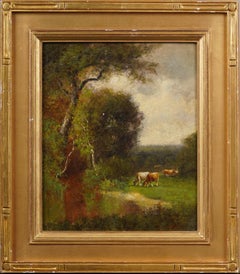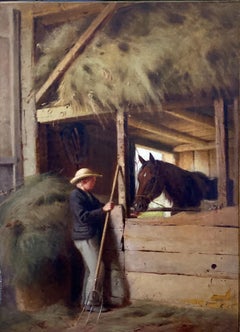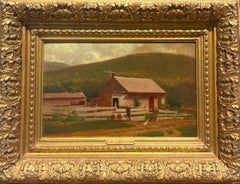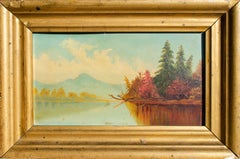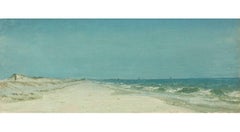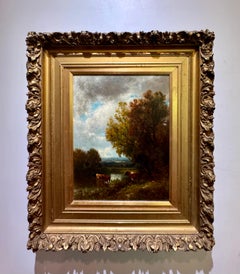William Hart Paintings
1823-1894
Born in Scotland, William Hart emigrated with his family to New York on the ship Camillus in 1830. He became known for serene, bucolic and romantic landscapes. Many of his paintings had cattle and realistic figures diminished in the landscape, a motif he began in the late 1880s. Hart was a second generation "Hudson River School" painter. George Inness and Asher Durand were major influences, although he was basically self-taught.
to
2
2
2
Overall Width
to
Overall Height
to
4
3
1
2
2
2
1
1
1
1
1
4
4
3
3
1
5
781
716
711
692
4
4
Artist: William Hart
Antique American Hudson River School Cows Grazing Signed Framed Oil Painting
By William Hart
Located in Buffalo, NY
Incredible early American Hudson River School landscape painting by William Hart (1823 - 1894). Oil on board. Framed. Signed. Measuring 15 by 17 inches overall and image size, 1...
Category
1870s Hudson River School William Hart Paintings
Materials
Oil, Board
$1,820 Sale Price
20% Off
"Interior of a Stable" William Hart, Hudson River School Antique, Boy and Horse
By William Hart
Located in New York, NY
William M. Hart (1823 - 1894)
Interior of a Stable
Oil on canvas
17 x 12 inches
Provenance
William Macbeth Gallery, New York
Mrs. Mabel Brady Garvan Collection
Christie's New York, Sporting Art, November 28, 1995, Lot 116
Ann Carter Stonesifer, Maryland
Estate of above
Brunk Auctions, Asheville, North Carolina, January 27 2018, Lot 777
Exhibited
New York, The Metropolitan Museum of Art, Life in America, April 24 - October 29, 1939, no. 123, illustrated.
New York, Macbeth Gallery, 1892: Sixtieth Anniversary Exhibition, April 1952, p. 5, no. 18.
Literature
Turner Reuter Jr, Animal and Sporting Artists in America, Middleburg, Virginia, 2008, p. 306.
Gary Stiles, William Hart: Catalogue Raisonné and Artistic Biography, no. 1126, illustrated.
It should be noted that the Francis Patrick Garvan and Mrs. Mabel Brady Garvan collection, of which this painting was a part of, was one of the foremost American Art collections and now makes up a large part of the Smithsonian American Art Museum and the Yale University Art Gallery collections.
Born in 1823 in Paisley, Scotland, William Hart emigrated with his parents to the United States at the age of nine and settled in Albany, New York. It was here that Hart first began his artistic training when he was placed under the tutelage of Messrs, Eaton & Gilbert, the prestigious coach-makers from Troy, New York. During this time, Hart learned how to decorate coach panels, covering them with either landscapes or figurative compositions. At the age of seventeen, he was eagerly contemplating an artist’s profession. Consequently, he left the mechanical trade of coach-making and began expanding his artistic pursuits to more refined endeavors.
Hart followed coach-making with decorating window shades and later developed an interest in portraiture. Around 1840, he established his first formal studio in his father’s woodshed in Troy. There, he created many likenesses of individuals, affording him a nominal income. Once, he remarked that he felt prouder over his first fee of five dollars for painting a head then for the larger sums he would command later in his career. Nevertheless, his wages from portraits during this early period proved insufficient. Thus, he expanded into landscape painting, allowing him to barter his works or sell them for modest prices.
In 1842, Hart moved to Michigan in an attempt to further his success; portraiture remained his primary means of support. Unfortunately, his experiences in the West were disappointing. Hart spent three years living a rough existence until he finally returned to Albany in 1845. Upon his return, he fully devoted himself to the art of landscape painting. Despite his failing health, he worked diligently to perfect his skill until 1849 when he traveled abroad to his native land of Scotland. This trip was made possible through the generosity of his patron and advisor, Dr. Ormsby of Albany. For three years, he studied in the open-air, creating brilliant sketches of the Scottish Highlands and the surrounding British Isles.
Returning to Albany once more in 1852, Hart enjoyed improved health and was reinvigorated with purpose. The following year, he moved to New York and opened a studio, promoting himself as a specialist in landscape painting. Hart became a regular contributor to the National Academy of Design. His works received a great deal of attention from artists and connoisseurs alike, all of whom praised him for his fresh, self-taught style. In 1855, he was designated as an associate of the National Academy of Design; three years later he was elected to Academician. In 1865, he was unanimously chosen to be the first president of the Brooklyn Academy of Design. It was during his tenure there that he delivered his famous lecture The Field and Easel, which emphasized the distinguishing principles of landscape art in America. Hart argued that landscape painters should express the “look of the place” being depicted.Critics during the 1870s noted his sensitive balance between capturing a strict “real” interpretation of nature and that of a more “ideal” sentimental tone. For instance, in 1869, Putnam Magazine noted that Hart brought back “exquisite studies” of the surrounding Tappan...
Category
19th Century Hudson River School William Hart Paintings
Materials
Canvas, Oil
$60,000 Sale Price
20% Off
"Pastoral Landscape, " William Hart, Hudson River School, Cloudy View with Cows
By William Hart
Located in New York, NY
William Hart (1823 - 1894)
Pastoral Landscape, 1877
Oil on canvas
9 1/2 x 14 1/2 inches
Signed and dated lower left
Born in Paisley, Scotland, William Ha...
Category
1870s Hudson River School William Hart Paintings
Materials
Canvas, Oil
Oil Landscape of Cabin In the Mountains
By William Hart
Located in Fredericksburg, VA
William Hart was an influential figure in the art world, best known for his contributions as a landscape painter during the 19th century. Born in Paisley, Scotland, in 1823, Hart imm...
Category
Late 19th Century Hudson River School William Hart Paintings
Materials
Canvas, Oil
Related Items
19th Century White Mountain Landscape, Unknown American School
Located in New York, NY
Unknown White Mountain Artist
White Mountain Landscape, 19th Century
Oil on board
5 x 9 1/4 in.
Framed: 7 3/4 x 11 3/4 in.
Category
19th Century Hudson River School William Hart Paintings
Materials
Board, Oil
On the Long Island Coast
By Sanford Robinson Gifford
Located in New York, NY
Prominent Luminist Hudson River School painter
Category
19th Century Hudson River School William Hart Paintings
Materials
Canvas, Oil
Dusk Forest Scene, Catskills by Lockwood DeForest (American, 1850-1932)
Located in New York, NY
"Dusk Forest Scene, Catskills," 1875 by Hudson River School painter Lockwood DeForest (American, 1850-1932) is oil on artists card-stock and measures 9.5 x 7 inches. The work is signed by DeForest, and dated May 13, 1875 at lower right. The work is framed in an elegant, period appropriate frame, and ready to hang.
Lockwood DeForest was born in New York in 1850 to a prominent family. He grew up in Greenwich Village and on Long Island at the family summer estate in Cold Spring Harbor. As was customary for a cultivated family in the Gilded Age, the DeForests made frequent trips abroad. Excursions to the great museums, which were prominent on the DeForests agenda, deepened the young Lockwood's familiarity with European painting and sculpture. Though he had begun drawing and painting somewhat earlier, it was during a visit to Rome in 1868 that nineteen-year-old DeForest first began to study art seriously, taking painting lessons from the Italian landscapist Hermann David Salomon Corrodi (1844–1905). More importantly, on the same trip, Lockwood met one of America’s most celebrated painters, (and his maternal great-
uncle by marriage) Frederic Edwin Church (1826–1900), who quickly became his mentor. DeForest accompanied Church on sketching trips around Italy and continued this practice when they both returned to America in 1869. Early on in his career, de Forest made a habit of recording the date and often the place of his oil sketches, as to create a visual diary of his travels. Lockwood’s profession as a landscape painter can be primarily attributed to Frederic E. Church and his belief in the young artist’s talent.
DeForest often visited Church in the Hudson River community of Catskill where, in addition to sketching trips and afternoons of painting, he assisted with the architectural drawings and planning of Olana. In 1872, DeForest took a studio at the Tenth Street Studio Building in New York. During these formative years DeForest counted among his friend’s artists such as Sanford Robinson Gifford (1823–80), George Henry Yewell (1830–1923), John Frederick Kensett (1816–72), Jervis McEntee (1828–91), and Walter Launt Palmer (1854–1932).
Over the next decade DeForest experienced success as a painter. He exhibited for the first time at the National Academy of Design in 1872, and made two more painting trips abroad, in 1875–76 and 1877–78, traveling to the major continental capitals but also the Middle East and North Africa. His trip to the Middle East and the library at Church’s home, Olana, established his interest in design during his mid-twenties. From about 1878 to 1902, landscape painting was overshadowed by his activities and preoccupation with East Indian architecture and décor, a style that became quite fashionable in late nineteenth century America. From 1879-1883, de Forest founded Associated Artists along with Louis Comfort Tiffany, Candace Wheeler...
Category
19th Century Hudson River School William Hart Paintings
Materials
Oil, Board
Parrot and Chrysanthemum, Interior Still Life by New Jersey Artist
By James Crawford Thom
Located in Doylestown, PA
Parrot and Chrysanthemum, by New Jersey artist James Crawford Thom, is an interior still life. The oil on canvas is 42 x 23.5 inches, it is signed "Thom" lower right, and it is framed.
Provenance: Private collection, Lambertville, New Jersey.
Contact us for additional shipping options.
Hudson River School style landscapist and genre painter James Crawford Thom was born in New York City in 1835, though he grew up on a farm just north of the City in Ramapo, New York. He studied at the National Academy of Design in New York City as an eighteen-year-old before going to Paris, where he studied with Camille Corot, Thomas Couture and Henri Picou...
Category
19th Century American Impressionist William Hart Paintings
Materials
Canvas, Oil
$7,800
H 45.5 in W 27 in D 2 in
Sandy Beach, Cohasset, 1860
By Winckworth Allan Gay
Located in New York, NY
Winckworth Allan Gay paints a scenic coastal scene from an elevated perspective overlooking a wave-filled beach below in his work entitled, “Sandy Beach, Cohasset.”
Category
Mid-19th Century Hudson River School William Hart Paintings
Materials
Canvas, Oil
Sunset on the Hudson River by Hermann Simon (American, 1846-1895)
Located in New York, NY
Painted by Hudson River School artist Hermann Simon (1846-1895) , "Sunset on the Hudson River" is oil on canvas, measures 15 x 25 inches, and is signed and dated 1875 at the lower ri...
Category
19th Century Hudson River School William Hart Paintings
Materials
Canvas, Oil
$15,000
H 15 in W 25 in
Antique American Fluffy Pomeranian Dog Portrait Wide Gold Frame Oil Painting
Located in Buffalo, NY
Incredible signed early American dog portrait painting. Oil on board. Signed. Housed in a period gold giltwood frame.
Category
1870s Realist William Hart Paintings
Materials
Canvas, Oil
$1,980 Sale Price
20% Off
H 27 in W 31 in D 2 in
Reflections of Trees at Dusk
Located in San Francisco, CA
Much about this late 19th-century painting remains a mystery, including the name of the artist who only left their identity in a single-letter monogram. But the work's moody embrace ...
Category
Late 19th Century Hudson River School William Hart Paintings
Materials
Canvas, Oil
Fishing Scene by Hudson River School artist John Carleton Wiggins (1848-1932)
By John Carleton Wiggins
Located in New York, NY
Summer Fishing Scene by Hudson River School artist John Carleton Wiggins (1848-1932) is oil on canvas and measures 12 x 20 inches. The painting is signed by Wiggins at the lower left...
Category
19th Century Hudson River School William Hart Paintings
Materials
Canvas, Oil
'Curious Kittens' by Charles Van Den Eycken (1859 – 1923) Romantic painter
By Charles Van Den Eycken
Located in Knokke, BE
Charles Van Den Eycken
1859 – Brussels – 1923
Belgian Painter
'Curious Kittens'
Signature: signed lower left and dated 'Ch. Van den Eycken 1900.'
Medium: oil on canvas
Dimensions:...
Category
19th Century Romantic William Hart Paintings
Materials
Canvas, Oil
$14,186
H 24.02 in W 28.35 in D 4.73 in
Landscape of Pond and Field After Rain Titled "Cranes After the Rain"
Located in Fredericksburg, VA
This serene landscape by a Hudson River School artist captures the quiet tension between storm and calm, rendered with luminous color and delicate brushwork. A soft sunset glows behi...
Category
Late 19th Century Hudson River School William Hart Paintings
Materials
Oil, Board
$5,800
H 9.5 in W 5.75 in
Antique oil painting, Boy Fleaing a Dog, Gerard ter Borch, Dutch golden age
Located in DEVENTER, NL
Gerard ter Borch (II) (1617-1681), copy after, around 1700
'Boy Fleas a Dog'
Oil on canvas
Professionally restored (cleaned and relined)
In modern frame in 17th century style
Dimensions excl. frame: 33 x 27,5 cm.
Dimensions incl. frame: approx. 50 x 45,5 cm.
Depcited is a boy busy fleaing a dog. The boy sits on a chair with the dog on his lap. On a table on the right there is a book and a pen. On a wooden bench lies the boy's hat.
What is unique about this painting by Ter Borch, is the relationship that is depicted between human and animal. Mostly animals like dogs where depicted as an attribute in paintings in the 17th century, and sometimes used to symbolize certain character traits. This boy is lovingly caring for his dog, which he is giving his full attention.
Another interesting detail is that Ter Borch's brother Moses, was probably the model for this painting. Ter borch often used family members as models for his paintings. Moses was also a very talented painter and draughtsman.
Several copies of this work by Ter Borch are known. One of these copies is in the collection of the Dutch Rijksmuseum (Image included in the image gallery (last image)).
The original painting is in the collection of the Alte Pinakothek museum in Munich, Germany.
Gerard ter Borch, also known as Gerard Terburg, was a Dutch genre painter who lived in the Dutch Golden Age. He influenced fellow Dutch painters Gabriel Metsu...
Category
Early 18th Century Old Masters William Hart Paintings
Materials
Canvas, Oil
$3,541 Sale Price
20% Off
H 19.69 in W 17.92 in
Previously Available Items
EXHIBITED American Hudson River COW School Landscape Stream with Cows
By William Hart
Located in New York, NY
William Hart (1823-1894), a Scottish-born American painter and member of the Hudson River School, famous for his oil paintings of atmospheric landscapes and cattle. His works are inc...
Category
Late 19th Century Hudson River School William Hart Paintings
Materials
Oil
Windsor Castle from the River Thames. An antique oil painting
By William Hart
Located in St. Albans, GB
William M. Hart
American 1823 - 1894
Outside Frame Size: 36 x 49" (90 x 122cm)
Canvas Size: 28 x 41" (70 x 102)
Provenance: H.V. Allison Galleries, New York
Born in 1823 in Paisley...
Category
1850s Victorian William Hart Paintings
Materials
Oil
H 36 in W 49 in D 3 in
Autumn Landscape
By William Hart
Located in Saratoga Springs, NY
Faintly signed lower right.
Born in Paisley, Scotland, William Hart became known for serene, bucolic, romantic landscapes with smooth finely executed brush-work. Many of his paintings had cattle and realistic figures diminished in the landscape, a motif he began in the late 1880s when he was inspired by the Lower Keene Valley in northern New York state. Hart also painted portraits, beginning this subject matter when he was age 18.
He, as well as his brother James McDougal Hart, was a second generation "Hudson River School" painter, and a sister, Julie Hart Beers was also a successful artist. George Inness and Asher Durand were major influences, although he was basically self taught.
Hart was the first president of the Brooklyn Academy of Design and also an instructor there. He was founder and three-term president of the American Watercolor Society, and his popular landscapes were exhibited regularly at the National Academy of Design and the American Art Union. He was a highly regarded teacher, and pupils included Homer Martin and Lemuel Miles.
He studied art in Scotland for three years and came to Troy, New York in 1831 as a young boy and apprenticed to Eaton and Gilbert Coachmakers where he painted decorative panels...
Category
Late 19th Century Hudson River School William Hart Paintings
Materials
Oil, Board
"Summer Landscape on the River, " William Hart, Hudson River School, Catskills
By William Hart
Located in New York, NY
William Hart (1823 - 1894)
Summer Landscape on the River
Oil on paperboard
5 x 8 1/2 inches
Signed lower right
Born in Paisley, Scotland, William Hart be...
Category
Late 19th Century Hudson River School William Hart Paintings
Materials
Oil, Board
"Summer Landscape on the River, " William Hart, Hudson River School, Catskills
By William Hart
Located in New York, NY
William Hart (1823 - 1894)
Summer Landscape on the River
Oil on paperboard
5 x 8 1/2 inches
Signed lower right
Provenance:
Peter Jung Fine Art, Hudson, N...
Category
Late 19th Century Hudson River School William Hart Paintings
Materials
Oil, Board
"Keene Valley, Adirondack Landscape" William Hart, Hudson River School Landscape
By William Hart
Located in New York, NY
William Hart (1823 - 1894)
Keene Valley, Adirondack Landscape, New York, 1873
Oil on canvas
9 x 16 inches
Housed in an East Lake frame
Signed and dated lo...
Category
1870s Hudson River School William Hart Paintings
Materials
Canvas, Oil
A Glorious Morning in Autumn
By William Hart
Located in Wiscasett, ME
Oil on board, signed lower right. Presented in what is likely the original frame.
Provenance: The Patricia Weiner Gallery, private Midwest Collection.
Measures 10" x 15" painting and with frame 20" x 25.75"
(March 31, 1823 – June 17, 1894), was a Scottish-born American landscape and cattle painter, and Hudson River School artist. His younger brother, James McDougal Hart, and his younger sister, Julie Hart Beers, were also Hudson River School artists...
Category
1870s Hudson River School William Hart Paintings
Materials
Oil
Autumn Landscape with Stream
By William Hart
Located in New York, NY
Signed lower left: WM HART; dated lower center: 1876
Category
19th Century Hudson River School William Hart Paintings
Materials
Oil
Hudson River School 1850's American Landscape with a Waterfall by William Hart
By William Hart
Located in Buffalo, NY
Hudson River School landscape with a waterfall by William Hart (1823 - 1894). Oil on canvas, circa 1850. Signed lower right. Displayed in a giltwood f...
Category
1850s Hudson River School William Hart Paintings
Materials
Canvas, Oil
William Hart paintings for sale on 1stDibs.
Find a wide variety of authentic William Hart paintings available for sale on 1stDibs. You can also browse by medium to find art by William Hart in canvas, fabric, oil paint and more. Not every interior allows for large William Hart paintings, so small editions measuring 24 inches across are available. Customers who are interested in this artist might also find the work of William Rickarby Miller, Ralph Albert Blakelock, and David Johnson. William Hart paintings prices can differ depending upon medium, time period and other attributes. On 1stDibs, the price for these items starts at $15,000 and tops out at $75,000, while the average work can sell for $45,000.
